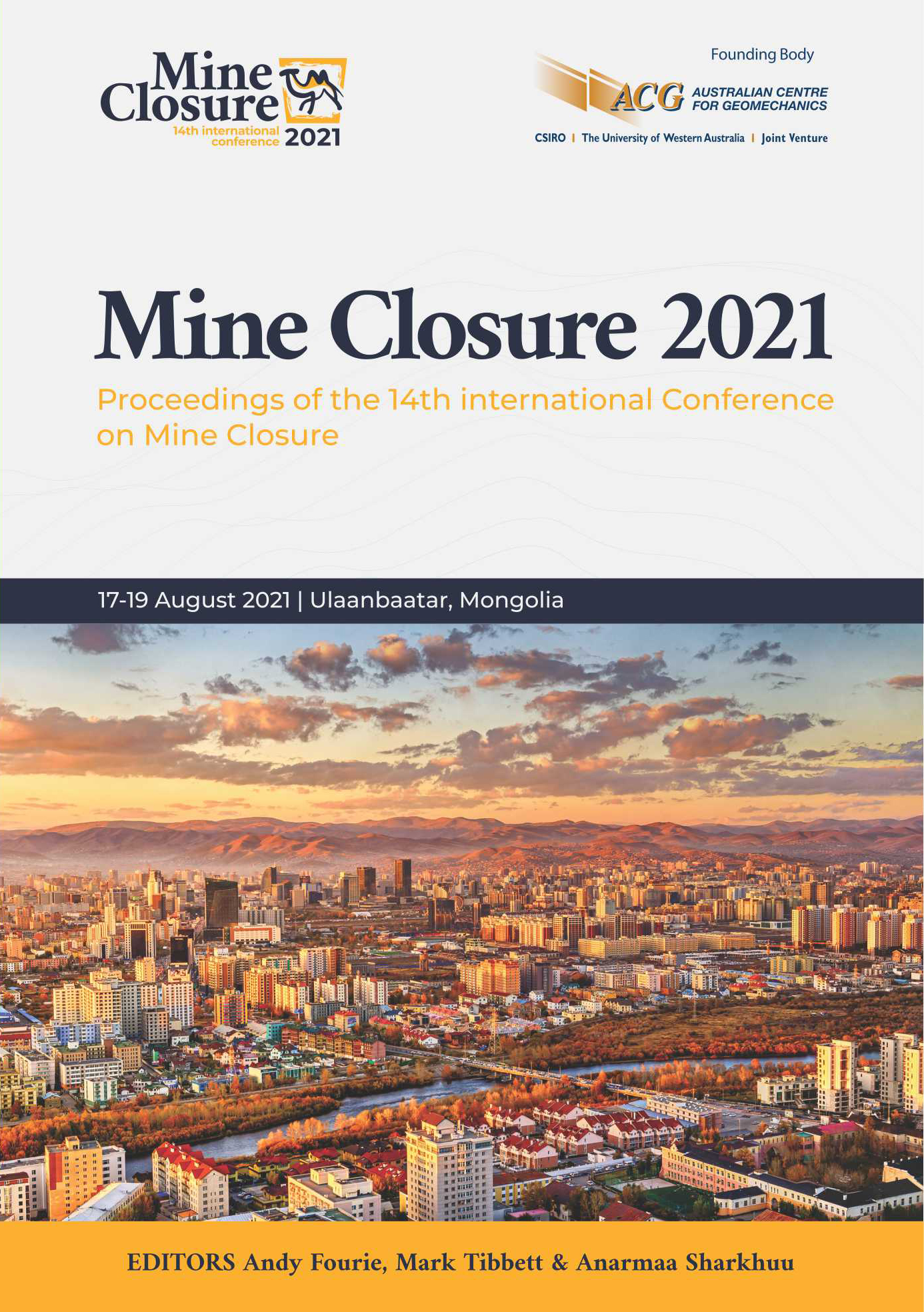A case study – from operation to closure, transient slope supplementation measures for the northern batters of the Hazelwood Mine, using the MGRI approach

|
Authors: Narendranathan, S; Faithful, J; Patel, N; Stipcevich, J |
DOI https://doi.org/10.36487/ACG_repo/2152_54
Cite As:
Narendranathan, S, Faithful, J, Patel, N & Stipcevich, J 2021, 'A case study – from operation to closure, transient slope supplementation measures for the northern batters of the Hazelwood Mine, using the MGRI approach', in AB Fourie, M Tibbett & A Sharkuu (eds), Mine Closure 2021: Proceedings of the 14th International Conference on Mine Closure, QMC Group, Ulaanbaatar, https://doi.org/10.36487/ACG_repo/2152_54
Abstract:
In the mining industry risk is conventionally applied under absolute conditions (e.g., operational scenarios or say a rehabilitated scenario); However, challenges arise when applying these methods to a mine that is in a transient state (i.e., transitioning from operational to final rehabilitated conditions). The closure of Hazelwood Mine, Victoria, Australia, presents a number of unique challenges in this regard. The Mine is considering a full pit lake as part of their rehabilitation and closure plan. Extensive batter stability analyses have indicated that partial lake fill options can lead to a sub optimal outcome for long term mine batter stability. The Northern Batters of the Hazelwood Mine are within close proximity to the Princes Freeway and Morwell township and have been identified as a ‘critical’ mine batter within the Ground Control Management Plan (GCMP). As such, more stringent design acceptance criteria have been nominated for the Northern Batters during the transient state. It has been determined that during lake filling some sections of the Northern Batters would require slope supplementation measures to be installed to further improve the stability outcome. The design of temporary slope supplementation measures in such transient scenarios (lake filling) need to be carefully considered as there can be an elevated risk profile where adequate treatment is not applied. The Mine Geotechnical Risk Index (MGRI) was developed by Narendranathan et al. (2019) to propose a methodology for quantifying risk under such transient states with specific consideration to mining and geological conditions in the Latrobe Valley. This paper presents a case study on the design of transient state slope supplementation measures for the Northern Batters of the Hazelwood Mine using the MGRI approach. This ultimately resulted in the identification of critical slope sections which required supplementation. The slope supplementation measures identified through the MGRI process and the method by which these slope supplementation measures are to be installed will be outlined in the paper.
References:
Ammann, WJ 2005, ‘Natural hazards: risk concept and integral risk management’, in WJ Ammann, S Dannenmann & L Vulliet (eds), Proceedings of RISK21 – Coping with Risks due to Natural Hazards in the 21st Century, A.A. Balkema, Rotterdam.
Ágústsson, K, Jóhanneson, T, Sauermoser, S, Sigurðsson, Hó & Jensen, EH 2003, Hazard Zoning for Bíldudalur, Vesturbyggð, Report 03034, Icelandic Meteorological Office, Reykjavík, viewed 6 February 2019,
Borter, P 1999, ‘Risikoanalyse bei gravitativen naturgefahren: methode’, Umwelt‐Materialien, no. 107/I.
Bell R, Glade, T & Danscheid M 2005, Risks in Defining Acceptable Risk Levels, University of Bonn, Bonn.
Harr 1984, Reliability-Based Design in Civil Engineering, Department of Civil Engineering, School of Engineering, North Carolina State University, 1984.
Jónasson, K, Sigurdsson, SP & Arnalds, P 1999, Estimation of Avalanche Risk, report VÍ‐R99001‐ÚR01, Icelandic Meteorological Office, Reykjavík.
Jóhannesson, T & Ágústsson, K 2002, Hazard Zoning for Debris Flows, Rockfall, Slushflows and Torrents and Slushflows Mixed with Soil in Steep Slopes, report TóJ/Kri‐2002/01, Icelandic Meteorological Office, Reykjavík, in Icelandic
Latrobe Valley Regional Rehabilitation Strategy 2019, Preliminary assessment of mine scale pit lake rehabilitation geotechnical risks for the Latrobe Valley Mines, Version 2, Department of Jobs, Precincts and Regions, August 2019.
Lilly, PA 2000, The minimum total cost approach to optimise pit slope design, Western Australia School of Mines, Kalgoorlie.
Malone, AW 2005, ‘The story of quantified risk and its place in slope safety policy in Hong Kong’, in T Glade, MG Anderson & M Crozier (eds), Landslide Hazard and Risk, John Wiley & Sons, Chichester.
Narendranathan, S 2009, ‘Fundamentals of probabilistic slope design and its use in pit optimization’, Proceedings of the 43rd US Rock Mechanics Symposium & 4th US ‐ Canada Rock Mechanics Symposium, American Rock Mechanics Association, Alexandria.
Narendranathan, S & Cheng, M 2019, 'Development of the Mine Geotechnical Risk Index', in J Wesseloo (ed.), Proceedings of the First International Conference on Mining Geomechanical Risk, Australian Centre for Geomechanics, Perth, pp. 461-474.
The Ministry of the Environment 2000, Reglugerð nr. 505/2000, Reglugerð um Hættumat Vegna Ofanflóða, Flokkun og Nýtingu Hættusvæða og gerð Bráðabirgðahættumats (Regulation on hazard zoning for avalanches, debris flows and rockfall, the usage of hazard zones, and the making of preliminary hazard zoning), viewed 16 August 2018, ‐2000
© Copyright 2025, Australian Centre for Geomechanics (ACG), The University of Western Australia. All rights reserved.
View copyright/legal information
Please direct any queries or error reports to repository-acg@uwa.edu.au
View copyright/legal information
Please direct any queries or error reports to repository-acg@uwa.edu.au
